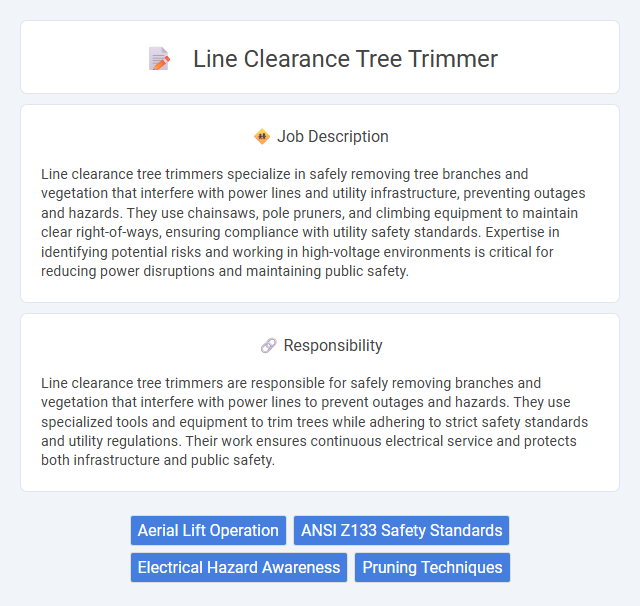
Line clearance tree trimmers specialize in safely removing tree branches and vegetation that interfere with power lines and utility infrastructure, preventing outages and hazards. They use chainsaws, pole pruners, and climbing equipment to maintain clear right-of-ways, ensuring compliance with utility safety standards. Expertise in identifying potential risks and working in high-voltage environments is critical for reducing power disruptions and maintaining public safety.
Individuals with strong physical stamina and a high tolerance for outdoor work in varying weather conditions are likely suitable for a Line Clearance Tree Trimmer job. Those who may struggle with heights, heavy manual labor, or unpredictable schedules might find this role challenging. The probability of job satisfaction and safety increases for candidates with experience in tree trimming, electrical safety, and the ability to work independently or in small teams.
Qualification
Line clearance tree trimmers require specialized training in arboriculture and electrical safety to safely remove vegetation near power lines. Certifications such as OSHA 10 or 30-hour safety training and utility-specific credentials like the International Society of Arboriculture (ISA) Certified Arborist are highly preferred. Strong physical fitness, knowledge of tree biology, and proficiency with chainsaws and climbing equipment are essential qualifications for this role.
Responsibility
Line clearance tree trimmers are responsible for safely removing branches and vegetation that interfere with power lines to prevent outages and hazards. They use specialized tools and equipment to trim trees while adhering to strict safety standards and utility regulations. Their work ensures continuous electrical service and protects both infrastructure and public safety.
Benefit
Working as a Line Clearance Tree Trimmer likely offers substantial benefits including competitive pay and opportunities for overtime, which can enhance overall earnings. The job may provide health and safety training, contributing to skill development and workplace security. Employment in this field often includes retirement plans and insurance benefits, supporting long-term financial stability.
Challenge
Line Clearance Tree Trimmer jobs likely involve challenging conditions due to working near high-voltage power lines, where precision and safety are paramount. The role probably demands navigating difficult terrain and handling heavy equipment, increasing the risk of accidents or injuries. Managing unexpected environmental factors such as weather changes could further complicate task execution and require quick problem-solving skills.
Career Advancement
A Line Clearance Tree Trimmer career offers significant growth opportunities through skill development in vegetation management, electrical safety, and equipment operation. Experienced trimmers can advance to supervisory roles, project management, or specialized positions in utility maintenance and forestry services. Continuous training and certifications in arboriculture and utility line standards enhance career progression and earning potential.
Key Terms
Aerial Lift Operation
Line clearance tree trimming requires expertise in aerial lift operation to safely access and maintain vegetation near power lines. Operators must be skilled in maneuvering bucket trucks and articulating boom lifts to perform precise trimming while minimizing safety risks. Proficiency in aerial lift safety protocols and equipment maintenance ensures efficient and secure tree removal and clearance activities.
ANSI Z133 Safety Standards
Line clearance tree trimmers adhere strictly to ANSI Z133 Safety Standards to ensure safe vegetation management near power lines, minimizing the risk of electrical hazards and facilitating reliable utility service. These standards emphasize proper use of personal protective equipment (PPE), safe pruning techniques, and mandatory training to prevent accidents during tree trimming operations. Compliance with ANSI Z133 promotes a safer work environment by enforcing clear guidelines on equipment handling, work positioning, and emergency procedures for line clearance arborists.
Electrical Hazard Awareness
Line clearance tree trimmers are trained to identify and mitigate electrical hazards when working near power lines to prevent accidents and ensure safety. They use specialized equipment and follow strict safety protocols to maintain proper distance from energized conductors, reducing the risk of electrical shock or arc flash. Awareness of electrical hazards and adherence to OSHA and NFPA 70E standards are critical for protecting workers and maintaining reliable utility infrastructure.
Pruning Techniques
Line clearance tree trimmers specialize in pruning techniques that enhance the safety and reliability of power lines by removing branches and foliage that could cause outages or hazards. They employ methods such as directional pruning, crown thinning, and flush cuts to maintain tree health while preventing interference with electrical infrastructure. Mastery of these techniques ensures efficient clearance, minimizes damage to trees, and supports utility companies in maintaining continuous power delivery.
 kuljobs.com
kuljobs.com